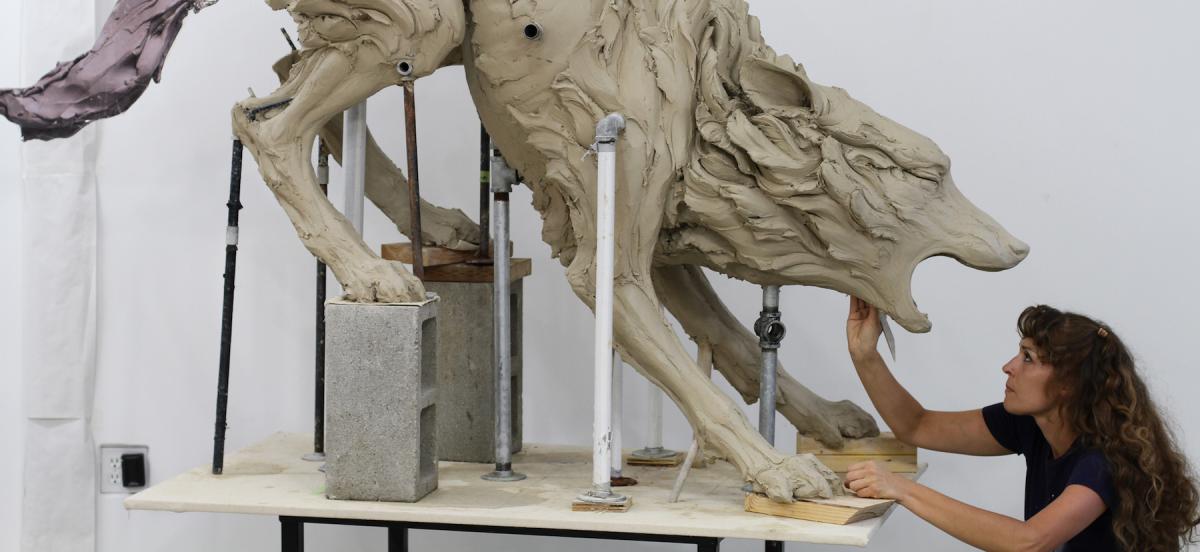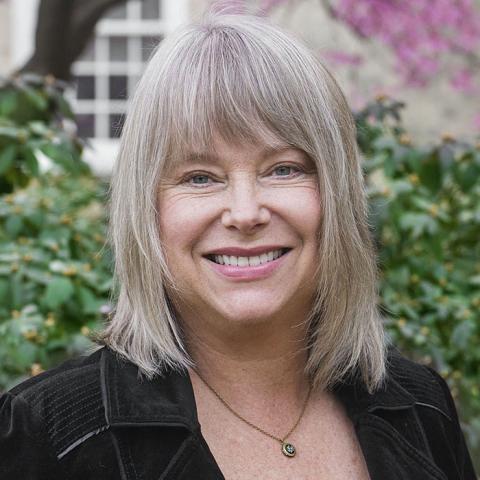Fine Arts Major Beth Cavener ’95 Has Made a Career Out of Her Passion

Beth Cavener '95 at work in her studio.
Details
The sculptor’s work has been showcased in venues as eminent as Metropolitan Museum of Art.
We will never know for certain the motives of the artists who created the Paleolithic cave paintings of animals at sites like Altamira and Lascaux more than 30,000 years ago. But the sensitivity and verisimilitude of those images is evidence of a primordial urge in humans to depict the fauna we share the planet with.
While sculptor Beth Cavener ’95 is frank about the motivations for her own animal forms, the results leave plenty of room for interpretation. Cavener’s ceramic creations are often life-size or larger, and sculpted with surfaces that can feature elaborate decorative patterns. Her unsettling menagerie includes a monkey shackled to a wolf, an elegantly tattooed serpent sinking its fangs into a rabbit, and a potbellied hare reclining in a louche pose. “I use animal bodies to encapsulate some sort of human emotion or idea,” says Cavener. “These are portraits of people, and there are collarbones, belly buttons, and human genitalia—parts of bodies that don’t belong on animals. Along with the gestures and the way they are expressing themselves, they are off-kilter and primal.”
Using animals as surrogates for human emotions or dilemmas is something we’re all familiar with, says Jason Busch, director of the Jason Jacques Gallery in New York City, which mounted The Other, a solo exhibition of Cavener’s work that closed Dec. 5. “We often learn about morals and life through narrative tales or fables read to us as children, and animals frequently take on a central role, because it can be easier for humans to understand and examine their own emotions and actions through the guise of animals.” In fact, Cavener has described the vignettes she creates with her ceramic figures as “morality plays.”
The daughter of an art teacher and a scientist, she says it was her molecular biologist father who inspired her sense of inquiry and interest in the natural world. “My father taught me from a really early age to ask questions over and over again, and that it was an intelligent way to dissect the world,” Cavener says. “I might take an emotion like fear or aggression, and I’ll spend a whole two-year period designing six or eight different characters that are dealing with fear and aggression in their own private ways.”
That persistence extends to Cavener’s labor-intensive studio practice. “The process I’ve created is something that I love,” she says. “It’s intense and it’s over the top, but it is how I enjoy thinking and working through the questions that are the basis for the pieces.”
Cavener’s animal forms start out as small models, which are then photographed, and the photographs blown up. That oversized image becomes the basis for a sculpture, which can require putting as many as 1,000 pounds of clay on a metal armature, cutting the figure into dozens of sections, hollowing out each part, and then reassembling the pieces before firing. Intricate surface painting and decoration come after the pieces are fired.
Cavener, who was a fine arts major at Haverford, earned an M.F.A. in ceramics from Ohio State University. She has had 12 solo exhibitions, and her work has been featured in numerous group shows and is in the collections of major art museums, including the Metropolitan Museum of Art, the Museum of Art and Design in New York, and the Smithsonian American Art Museum. Previously based in eastern Washington, after a series of artist-in-residence programs in the United States, China, Italy, and Japan, Cavener relocated to Helena, Mont., which she got to know and love during a residency at the town’s pioneering Archie Bray Foundation for the Ceramic Arts. In 2014, she and fellow ceramic artist and partner Alessandro Gallo (the couple has a 3½-year-old son) teamed up with two other artists to launch a collaborative studio in an old distillery building in downtown Helena. The space, called Studio 740, is not only home base for the four founders, it also offers studio space for artists in transition, sponsors artist residencies and internships, and runs workshops. “I love teaching and mentoring,” says Cavener.
Besides appreciating the inspiring community of ceramic artists that have been drawn to Helena by the Bray Foundation, Cavener has grown to love the town for another reason: “It’s the history behind it. It’s got that old Gold Rush feel to it. There’s still a sense of making a discovery.”




